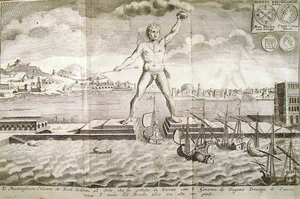Colossus of Rhodes
The Colossus of Rhodes was a statue of the Greek god Helios and considered one of the Seven Wonders of the Ancient World. In 305 B.C. Demetrios Poliorketes began the siege of Rhodes. The siege of the city was lifted the following year when the citizens came to an agreement to support Demetrios. In celebration of the end of the siege, a statue of the sun god, Helois, was built. Chares of Lindos designed and built the bronze statue, which took 12 years to build. It was about 33m high and collapsed during an earthquake in 226 B.C., just 56 years after it was finished.[1][2] Though the inhabitants of Rhodes wished to see the statue rebuilt this never came to fruition. However, the remains of the statue became a tourist attraction in their own right.[3]
Little is known about the statue, and not even its precise location has been determined, and even how it looked is uncertain. In assessing the information compiled on the Colossus, archaeologist Reynold Higgins remarked that while 16 writers in Antiquity mentioned the statue only three give much detail. According to Pliny the Elder (one of the three more useful sources) the statue cost 300 talents to build.[1] Because the form the statue is unknown, it has been the subject of much speculation. According to popular tradition the Colossus stood at the entrance to Rhodes' harbour, and stood with legs apart, one either side of the harbour entrance (see illustration). This has, however, been dismissed as impractical as the feet would have been about 400m apart and it more likely that the statue was of an upright figure for stability, and the arms would not have been outstretched.[4] It is now thought that the statue stood close to the Temple of Helios, which archaeological excavations have located east of the city's acropolis. Archaeologists have also discovered foundries near the temple which may indicate the pieces were created there to minimise the distance they had to be transported.[5]
References
- ↑ Jump up to: 1.0 1.1 Higgins, Reynold (1988). “The Colossus of Rhodes” in Peter A. Clayton and Martin J. Price (eds.) The Seven Wonders of the Ancient World. London: Routledge. pp. 127–128. ISBN 0-415-05036-7.
- ↑ Rice, Ellen (1993). “The glorious dead: Commemoration of the fallen and portrayal of victory in the late classical and hellenistic world” in John Rich and Graham Shipley (eds.) War and Society in the Greek World. Padstow: T. J. Press. pp. 235–236. ISBN 0-415-06643-3.
- ↑ Higgins, “The Colossus of Rhodes”, pp. 11–12.
- ↑ Higgins, “The Colossus of Rhodes”, pp. 133–134.
- ↑ Rice, “The glorious dead”, pp. 236–239.
